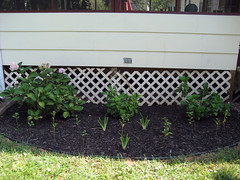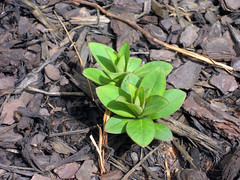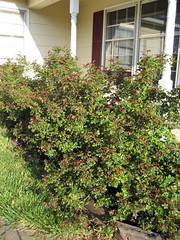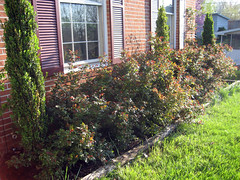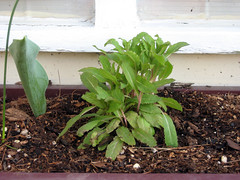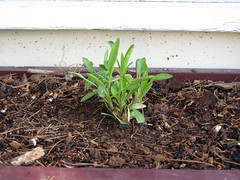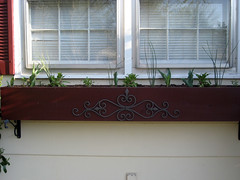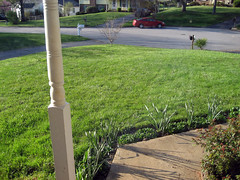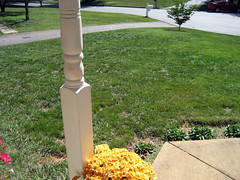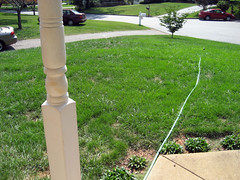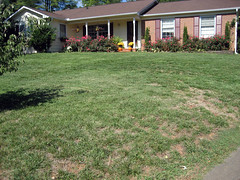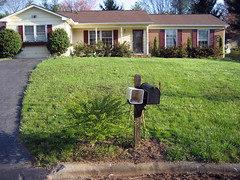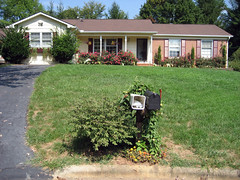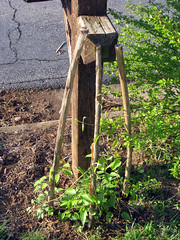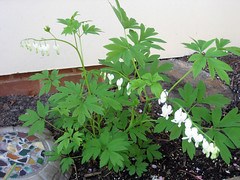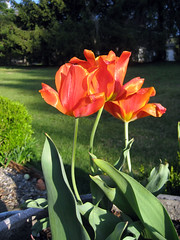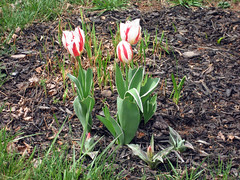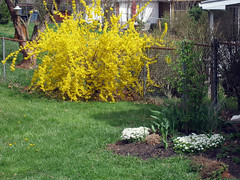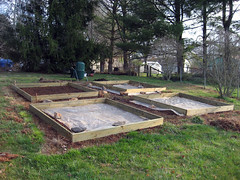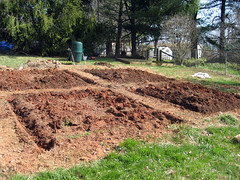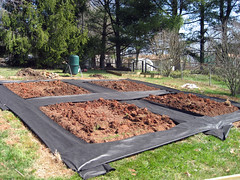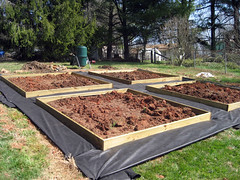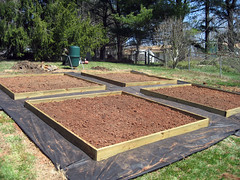Over the past two weekends we finally finished constructing the vegetable garden. I am so proud of us! We would have finished sooner if the weather had cooperated, but I won't complain about rain after last year's nasty drought.
Our first task was to outline the garden with black plastic edging and "tuck" the garden cloth into the gap between the edging and the sod. Sounds easy, yes? Well, this was the most tedious and difficult task yet! I think the work paid off though. Take a look for yourself. (Beware my very white husband is shirtless in some of these photos. You may want to wear your sunglasses.)
I wanted 18" pathways along the edge of the garden so there is enough room to work from all sides of the garden beds. So, we inserted garden pins at 2' intervals 18" from the garden beds to use as a guideline for inserting the edging. We then used a flat-head shovel to create an outline around the entire garden, indicating where the plastic edging would be inserted.

We then cut the garden cloth to about 22", leaving enough room to tuck the extra cloth into the space between the plastic edging and the ground.
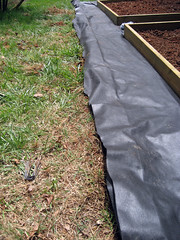
Now for the real fun. One person inserted the flat-headed shovel into the already cut trench and rocked the shovel forward and backward to create a trench wide enough to insert the plastic edging and garden cloth into. The other person shoved the garden cloth into the trench followed by the plastic edging. This was really hard on the back - too much stooping!

After the entire row of edging was in place, we tamped down the soil on both sides of the edging to ensure the edging stays put; otherwise, it will heave out of its trench. This was difficult too. Our tamping legs were burning by the end of the day!
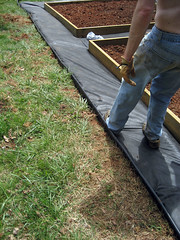
So there you have it - a nicely edged garden.
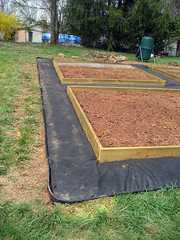
This task took about 4 hours to complete, but I will admit that we could have worked faster had we not taken a 30 minute break to dig for earthworms. You know you are tired when you're amused by finding earthworms! We found about 50 worms. I was considering starting a bait and tackle shop - LOL!
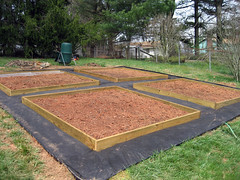
The next weekend we installed the fence. Last year's fence was chicken wire stapled to wooden stakes. It was hideous.
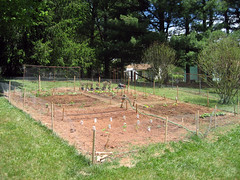
I decided this year that we would invest some time and money into a more permanent fence structure. I still wanted a fence that I could easily step over, but please, no chicken wire. Also, I don't want to have to take it down and resurrect it each year. So, off to Lowe's we went. We didn't find my ideal fence there, but we found something I considered adequate. It was under $100 and it looks a lot better than last year's version. I think I can make do with this fence for a couple years at least. Maybe Ian will construct a nice little white picket fence for me in the future.

The fence is green plastic-coated wire, much thicker than chicken wire and a lot more aesthetically pleasing. We used green metal stakes with little hooks to which the fence is affixed. (I was looking for these same stakes last year and couldn't find them - which explains the hideous vampire killing wooden stakes of last year.)
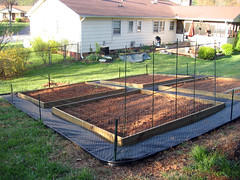
The fence didn't turn out exactly as I had hoped, but I am still happy with it. I wanted to plunge the fence into the ground a couple inches to ensure bunnies keep their little cotton tails away from my crops, but it was going to make the job infinitely longer. The job took over 2 hours as it was, and I didn't want to push my luck with Ian's patience. He has been such a trooper through this all! I am going to buy some garden pins to secure the bottom of the fence to the ground so bunnies cannot squeeze under the fence. Hopefully this will make a bunny-proof structure.
There are two tasks left; 1 - construct a gate, and 2 - cover the garden cloth with mulch. Ian is going to make me a gate sometime in the nearish future. We are discussing how to build the gate at the moment. Since I can step over the fence easily, this is not a pressing issue at the moment. Mulching the garden cloth is no big deal. We just need to buy the mulch and haul it up to the garden. I would leave it uncovered, but the garden cloth is really SLIPPERY when wet, and it gets REALLY hot since it absorbs the sun. I wouldn't want to spend much time up there in the summer, and that would be a problem!
So there you have it. Task completed. Well, almost :) Our next mission is to rebuild the herb box. The herb sale at the Farmer's Market is on the 26th, so we need to get that box built this weekend!
Labels: asheville, gardening
